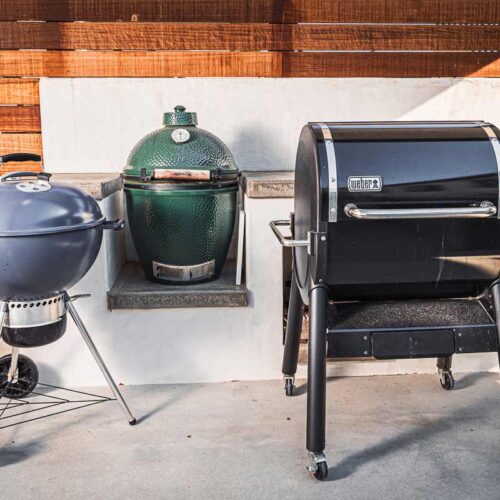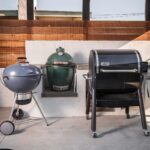With all of the different types of BBQ smokers out there, it can be pretty overwhelming trying to decide what cooker is going to be best for you. People ask me all the time what cooker they should get. Your specific situation will dictate the best option. Whether you want the most hands-off experience possible, or you want to spend all day tending to the fire, we’ll go through the most popular options.
Smoking meat at home has become so popular, and for good reason. The technological advances and much more accessible price points in BBQ smokers in the last few years has is a big reason for the growing popularity.
The Different Types of BBQ Smokers
This guide compares various types of cookers, including pellet smokers, kamado grills, electric smokers, offset smokers, and more. We will highlight their main features, the pros and cons for each and which might be the best for you.
Pellet Smokers
Pellet smokers, also known as pellet grills, use compressed sawdust wood pellets as their fuel source and to produce smoke flavor. Pellet smokers are usually controlled by a digital panel that allows you to easily set the desired temperature and monitor it throughout the cook. The pellets are loaded into a hopper and automatically fed into the firebox, creating consistent heat and adding a smoky flavor to the meat.
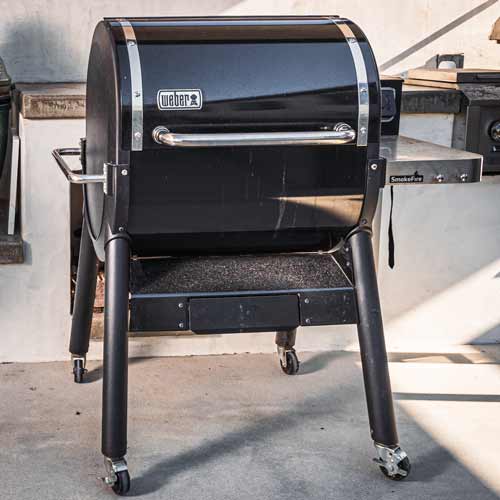
Pros:
- Convenience: Pellet smokers have automated pellet feeding, making them as easy to start and use as your indoor oven. They often have built-in probe thermometers and Bluetooth wireless connectivity so you know when the food is ready or if you need to add more fuel.
- Versatility: Pellet smokers can grill, smoke, bake, roast, and some can even sear.
- Temperature control: The digital control panel provides precise and automatic temperature regulation, though readings are often not totally accurate.
- Flavor variety: Wood pellets are available almost everywhere and come in various flavors, allowing you to experiment with different smoky tastes.
Cons:
- Taste: There is a significant difference between the smoky flavor you get with a pellet grill and that which you can achieve with a charcoal or wood smoker. There are many easy ways to get more smoke flavor from your charcoal grill, which include using a pellet tube which will create smoke on its own, or use the smoke mode if your pellet grill has one.
- Cost: Quality pellet smokers can cost more than other types, though cheaper models are readily available.
- Maintenance: Regular clean-outs between use of pellet ash and any grease is required for proper functionality.
Kamado Grills
Kamado grills are heavy ceramic or clay cooking devices that originated in Japan. These grills have excellent heat retention and are designed to circulate hot air around the meat. They are known for their versatility and the ability to reach very high temperatures for searing and grilling, or low temperatures over a long period of time for smoking.
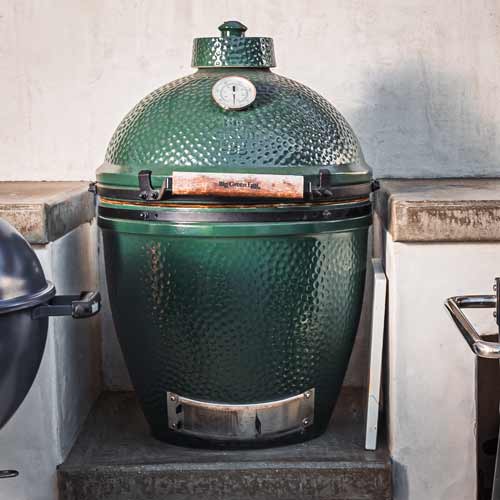
Pros:
- Temperature control: Kamado grills allow precise temperature adjustments with the use of vents.
- Fuel efficiency: These grills are able to cook for 18 hours or more on a single load of charcoal (depending on the size of the grill), requiring less fuel and the ability to reuse unburned lump charcoal if it is a shorter cook.
- Flavor: Cooking with live fire of lump charcoal and wood chunks allows you to add tons of fantastic flavor to the food.
- Versatility: Kamado grills can be used for grilling, smoking, roasting, baking and even as a rotisserie.
- Durability: The ceramic or clay construction provides long-lasting durability. All of the attached parts are replaceable, giving these grills a very long life even if stored outside in the elements.
- Multiple sizes: There is a large range of sizes available from a tiny 10″ diameter (79 in²) cooking area to a giant 29″ diameter (672 in²) of cooking area.
- Use it year-round: Because of its thick ceramic housing, kamados are able to cook in cold weather and winter conditions, unlike many smokers.
Cons:
- Price: Kamado grills can be more expensive than other types of charcoal smokers. Many accessories and add-ons are usually needed to perform all types of cooks.
- Learning curve: It can take some practice to master temperature control and cooking techniques, but once you understand the basics, they are quite easy to use.
- Weight: Kamado grills are quite heavy and are not very portable, except for the small-size versions.
Vertical Electric and Gas Smokers
Vertical smokers look similar to a mini-fridge and use either electricity to power a heating element or gas, which generates heat to ignite wood chips for smoke at the bottom of the smoker. The heat and smoke pass the food on racks before it escapes through the chimney at the top.
These smokers are easy to use and require minimal effort, making them a good choice for beginners or those looking for a hassle-free smoking experience. A Masterbuilt electric smoker [link]was my first smoker, and I cooked some great meals on it.
Pros:
- Convenience: Electric smokers are easy to use and require minimal monitoring.
- Temperature control: Most models offer precise temperature control settings.
- Ease of cleaning: These smokers generally have removable racks and drip pans, making cleanup quite easy.
- Price: These smokers can often be purchased for under $200.
Cons:
- Flavor: Electric smokers produce a milder smoky taste and the quality of the smoke is often not as good compared to charcoal and other wood smokers.
- Limited versatility: They are primarily designed for smoking and aren’t able to grill or roast.
Offset Smokers
Offset smokers, also known as stick burners and barrel smokers. They feature a firebox attached to the side of a cooking chamber. They rely on indirect heat from the smoke to cook the meat slowly with incredible smoky and authentic BBQ flavors.
Standard offset smokers have a chimney opposite the fire box, causing the smoke and heat to be pulled across the food as it cooks. Reverse flow offset smokers have the chimney on the same side as the fire box and force the smoke and heat to first travel under the food, and then over it as it flows.
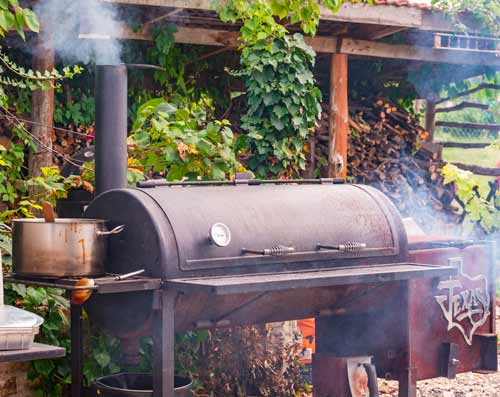
Pros:
- Flavor: Offset smokers are renowned for producing rich, traditional smoky flavors.
- Large cooking capacity: These smokers are available in various sizes all the way up to full trailers for making large quantities of meat.
- Versatility: Offset smokers can be used for smoking and many have the ability to grill over direct heat.
- Easy refueling: Because of the separate fire box, it’s easy to add more wood without opening the lid to the smoker.
Cons:
- Learning curve: Achieving consistent temperatures and smoke circulation requires practice.
- Time-consuming: Offset smokers often require more time and attention during the cooking process. It will usually take at least an hour to get the fire going and at the desired temperature.
- Frequent refueling: An offset smoker will need to be refueled more often than most smokers, often every 30 to 60 minutes to keep the fire going.
- Frequent adjustments: Maintaining the temperature can be difficult and can require constant tweaking to keep it consistent.
- Price: Quality offset smokers are not cheap. Avoid the cheap ones as you won’t get great results with all the effort they will take.
Barrel Smokers
Barrel or drum smokers are cylindrical smokers often made from repurposed oil drums or custom-built barrels. These smokers feature a firebox at the bottom with a heat plate separating the cooking grate on top for indirect heat smoking. The meat is either placed on grates or can be hung above the heat, giving you lots of cooking capacity.
Pros:
- Affordability: Barrel/drum smokers can be budget-friendly compared to other types.
- Capacity: They often have a large cooking area, accommodating significant quantities of meat.
- Customization options: Drum smokers can be easily modified or personalized to suit individual preferences.
Cons:
- Limited temperature control: Maintaining precise temperatures can be challenging with some barrel smokers.
- Learning curve: Achieving consistent results can require practice and experimentation to get it right.
Kettle Charcoal Grills
Charcoal kettle grills, like the iconic Weber kettle grill, can be used for smoking meat with certain techniques with outstanding results. These grills feature a domed lid and use charcoal as a fuel source.
If you already have a kettle grill, this is probably the best cooker to get started with for smoking.
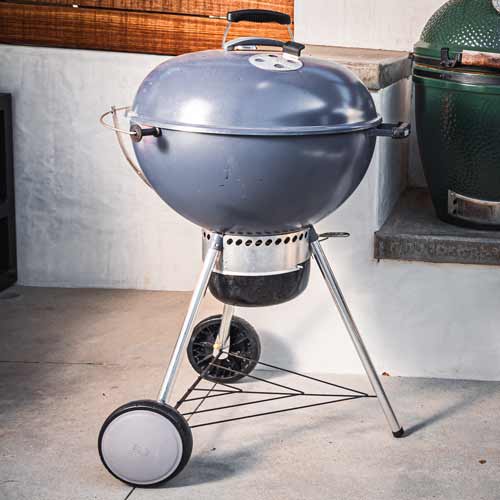
Pros:
- Versatility: Kettle grills can be used for grilling, smoking, and indirect cooking.
- Inexpensive: They are often more affordable than dedicated smokers.
- Portable: Kettle grills are lightweight and easy to transport and stored.
Cons:
- Not efficient: Because of the thin walls which make these grills light and portable, they lack insulation causing the heat to escape rather than stay in the cooker. Maintaining the temperature for long cooks can be a challenge without adding more fuel.
- Not truly indirect heat: Even with a two-zone grill setup, there isn’t a physical barrier to the hot heat.
Gas Grills as Smokers
Gas grills, typically fueled by propane or natural gas, are primarily used for grilling but can also be utilized as smokers. By creating indirect heat and adding wood chips to a box or pellets to a pellet tube, you can also use a gas grill to smoke and slow-cook meats.
Pros:
- Convenience: Gas grills are easy to use, ignite quickly, and offer precise temperature control.
- Versatility: They are primarily designed for grilling but can be adapted for smoking.
- Heat control: Gas grills allow for effortless adjustment of heat levels during the cooking process.
- Ability to sear: Searing meat after it has been slow-smoked is super convenient with a gas grill.
Cons:
- Less smoky flavor: Gas grills will produce a milder smoky flavor compared to other types of smokers.
- Limited airflow control: Some gas grills have limited vent options, making temperature and airflow control more challenging.
Cold Smokers
Cold smokers are designed specifically for smoking food at low temperatures without actually cooking it. They produce smoke that can be piped into a separate smoking chamber or even a regular grill or smoker to infuse the meat with smoky flavors. These are great for smoking salmon, cheeses or other meats like duck breasts that you would then cook with traditional methods.
Pros:
- Cold smoking capability: Cold smokers excel at producing cold smoke for delicate foods like cheese or fish.
- Versatility: Cold smokers can be used as standalone units or attached to existing smokers or grills.
- Flavor enhancement: Cold smoking imparts a mild smoky flavor without cooking the meat.
- Long smoking duration: Cold smoking allows for long smoking sessions without using much fuel.
Cons:
- Limited to cold smoking: Cold smokers cannot achieve high cooking temperatures and are not suitable for hot smoking.
- Keeping them cold enough in hot temperatures: It can be difficult to keep the temperature in the smoker cold enough to be safe during hot weather. Careful temperature regulation and monitoring is required for proper food safety.
Handheld Smokers
Handheld smokers, like the Breville Smoking Gun, are compact and portable devices used for infusing smoky flavors into food and cocktails. They work by generating smoke using wood chips or pellets and directing cool smoke through a tube to the desired food item.
Pros:
- Portability: Handheld smokers are compact and can be used both indoors and outdoors.
- Quick smoke infusion: These devices efficiently add smoky flavors to various foods.
- Versatility: Handheld smokers can be used on cooked or raw foods, enhancing their taste with a type of wood that pairs with the ingr.
- Ease of use: They require minimal setup and cleaning.
Cons:
- Limited smoking capacity: Handheld smokers are suitable for small quantities of food and won’t do much for larger cuts of meat.
- Limited to flavor infusion: They do not cook or provide traditional smoking techniques.
- Smoke retention: The smoky flavor can dissipate relatively quickly, requiring immediate consumption.
Portable Tabletop Electric Grill with Smoke
A new grill to the category is the Ninja Woodfire Outdoor Grills and Smokers, which has the ability to grill, smoke, air fry, bake, roast and even dehydrate. The big feature that makes this outdoor electric grill different (and why it’s in this guide), is its ability to produce real wood smoke by burning pellets. I have been really impressed with how this grill can cook and flavor with smoke – Check out these smoked chicken wings I made with it.
Pros:
- Portable and Mobile: This grill can be picked up with one arm and you could take it with you to cook wherever you can plug it in.
- Perfect for apartments and strict HOAs: This grill will allow you to grill with some smoke on a small deck.
- Cooks fast and with flavor: You get great flavor while cooking fast.
Cons:
- Limited capacity: This grill isn’t huge, so you can’t cook up a feast for a large party all at once.
- Limited “smoke”: The pellet capacity will burn within 30 minutes and will need to be re-filled.
Which Smoker is Best?
Choosing the right smoker depends on various factors, such as the time. you can dedicate, your lifestyle, the fuel you prefer, how much space you have and your budget. If you have a busy schedule with young kids and a full-time job, convenience and ease of use will likely be a priority, while those who have more time free time might prioritize flavor and a more involved cooking process.
Best for the Beginner
Best Smoker: Electric Smoker (or a kettle charcoal grill if you already have one)
A kettle charcoal grill or vertical electric smoker are a great cooker to start with. If you already have a kettle charcoal grill, then definitely start there. Electric smokers are super user-friendly and require minimal monitoring, and are perfectly suited for beginners who want hassle-free cooking experiences.
The Busy Family Entertainer
Best Smoker: Pellet Grill Smoker
If you are more of a hands-off cook and want more free time during the cook (instead of tending to the fire), a pellet grill is the answer. Pellet smokers are versatile, with the ability to smoke, grill and bake without a big time commitment.
The Expert Flavor Purists
Best Smoker: Offset Smoker
An offset smoker is going to deliver the best authentic BBQ flavors while requiring the most attention, practice and meticulous technique to deliver those results. You will need the time to dedicate to and enjoy the process, but it will be worth it.
The One for Everything
Consider a Kamado-style grill like the Big Green Egg as your do-everything workhouse cooker with maximum flavor and the ability to be set on autopilot. Out of the various cookers that I have, my Big Green Egg is what I turn to when I want the best flavor with just a little more effort than the pellet grill.
II. Conclusion Choosing the right BBQ smoker depends on personal preferences, cooking needs, and budget. Each type of smoker offers unique advantages and considerations. Whether you opt for the convenience of an electric smoker, the versatility of a pellet smoker, the authenticity of an offset smoker, or the heat retention of a kamado grill, experimentation and practice are key to mastering the art of smoking meat and achieving mouthwatering results.
A Few Tips
- Maintenance and cleaning are key: Remove ash, coals and accumulated grease to keep it running smoothly for a long time. Clean the grates (while still warm after the cook).
- Keep it covered: Leaving most smokers out in the elements can cause them to rust and degrade over time.
- Use a water drip pan: This will help regulate the temperature, catch drippings and increase the humidity of the cooker’s environment which is optimal for smoking.
- Temperature control is key: Being able to maintain temperature and avoid large fluctuations in your smoker will lead to the best results. Too hot will cause it to cook too fast, and too low can produce bad smoke.
- Don’t rely on the cooker’s built-in thermometer: Built-in thermometers are notoriously inaccurate and can easily be off by 100°, which can leave you wondering why something cooked too fast or too slow. Use a remote thermometer like the Thermworks Smoke to keep an eye on the actual temperature and adjust accordingly. Learn more about the best meat thermometers.
- Cook to temperature rather than by time: With all of the variables, using a thermometer to tell when your food is done rather than a timer will lead to the best results.

